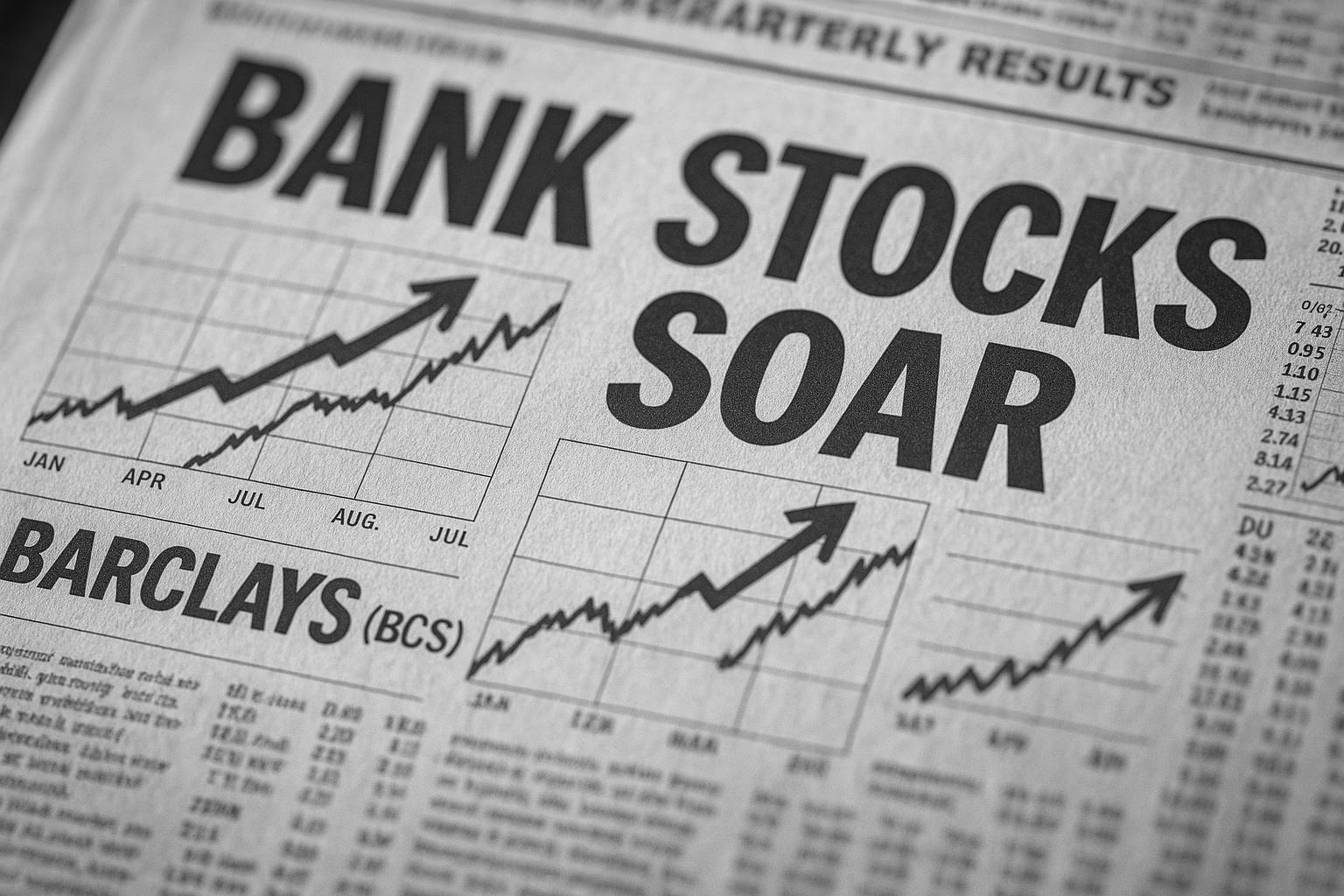Barclays has seen its shares soar nearly threefold since 2023, driven by strategic acquisitions and improved profitability. However, economic uncertainties and challenges in its US division prompt cautious investor sentiment despite strong dividends and robust earnings growth.
The Barclays share price has experienced a remarkable surge over recent years, delivering an impressive 191% gain over the past five years. From a low base of about 130p in late 2023, the stock now trades at approximately 343p, reflecting a significant value increase for investors. This strong performance was arguably overdue, considering the bank’s fundamental transformation and improving investor sentiment.
Barclays’ stellar growth in share price aligns with its ongoing strategic transformation, focused on driving efficiency and diversifying revenue streams. This includes notable acquisitions such as Tesco Bank and expansion into private credit, helping the bank reduce its reliance on more cyclical business segments. The group’s financial results underscore this progress, with the first quarter earnings showing an 11% year-on-year increase in total income to £7.7 billion and a 19% rise in profit before tax to £2.7 billion. The investment banking division particularly shone, leveraging heightened market volatility to post a 16% revenue increase. Barclays’ return on tangible equity (RoTE), a crucial measure of profitability, hit 14% for the quarter—comfortably above the full-year target of around 11%. Additionally, management has upgraded its net interest income guidance for 2025, further bolstering confidence in future earnings.
The bank’s share price also held a commendable momentum in 2024, rising by around 36.6% during the first half of the year and outperforming major indices like the S&P 500 and Nasdaq Composite, which gained under 9% over the same period. Besides capital appreciation, Barclays shareholders have also benefited from strong dividend yields. For those who invested around 130p in 2023, the dividend yield was approximately 5.5%, reflecting the bank’s robust cash returns to investors.
Despite this impressive track record, questions linger about whether Barclays’ share price has peaked. While the current valuation, at a price-to-earnings (P/E) ratio of about 8.4, appears discounted relative to many global banking peers, it does suggest some cautious optimism. Projections indicate the P/E could fall to six times by 2027, accompanied by a dividend yield increase from 2.6% to 3.4%, assuming the bank continues delivering on its strategic goals amid favourable market conditions. However, significant risks remain. Macroeconomic uncertainties—such as concerns over global growth, escalating US debt, and declining UK house prices—pose threats to credit quality and consumer demand. Barclay’s US Consumer Bank division also continues to struggle, which could impact the wider group if the US economy deteriorates.
Given these factors, some investors may exercise caution in increasing exposure due to concentration risk, especially if they already hold substantial positions in Barclays and other UK banks like Lloyds. Nonetheless, a generally bullish view persists over the long run, provided economic conditions remain stable. The sustained environment of central bank interest rates between 2% and 3.5% could foster profitability for lenders like Barclays, making the stock a compelling consideration for investors looking at steady gains from a major UK financial institution.
 Reference Map:
Reference Map:
- Paragraph 1 – [1], [3], [5], [7]
- Paragraph 2 – [1], [3], [5], [7]
- Paragraph 3 – [2], [4], [6]
- Paragraph 4 – [1], [3], [5], [7]
Source: Noah Wire Services
- https://www.fool.co.uk/2025/07/12/has-the-barclays-share-price-hit-a-peak/ – Please view link – unable to able to access data
- https://www.fool.co.uk/2024/05/07/up-37-in-2024-the-barclays-share-price-is-thrashing-the-market/ – In 2024, Barclays’ share price experienced a significant surge, outperforming major indices. Starting the year at 153.78p, it rose to 210.05p by mid-May, marking a 36.6% increase. This performance was notably higher than the S&P 500’s 8.8% and the Nasdaq Composite’s 8.9% gains over the same period. The article highlights the stock’s resilience and the potential for continued growth, excluding cash dividends, which have also risen steeply at British banks.
- https://www.fool.co.uk/2025/07/12/has-the-barclays-share-price-hit-a-peak/ – The article discusses Barclays’ impressive 191% gain over the past five years, with the share price rising from 130p in late 2023 to 343p. It attributes this growth to the bank’s strategic transformation, strong financial results, and improved investor sentiment. The piece also notes the bank’s ongoing focus on efficiency and diversification, including acquisitions like Tesco Bank and expansion into private credit, which have diversified revenue streams and reduced reliance on more cyclical segments.
- https://www.fool.co.uk/2024/05/07/up-37-in-2024-the-barclays-share-price-is-thrashing-the-market/ – In 2024, Barclays’ share price experienced a significant surge, outperforming major indices. Starting the year at 153.78p, it rose to 210.05p by mid-May, marking a 36.6% increase. This performance was notably higher than the S&P 500’s 8.8% and the Nasdaq Composite’s 8.9% gains over the same period. The article highlights the stock’s resilience and the potential for continued growth, excluding cash dividends, which have also risen steeply at British banks.
- https://www.fool.co.uk/2025/07/12/has-the-barclays-share-price-hit-a-peak/ – The article discusses Barclays’ impressive 191% gain over the past five years, with the share price rising from 130p in late 2023 to 343p. It attributes this growth to the bank’s strategic transformation, strong financial results, and improved investor sentiment. The piece also notes the bank’s ongoing focus on efficiency and diversification, including acquisitions like Tesco Bank and expansion into private credit, which have diversified revenue streams and reduced reliance on more cyclical segments.
- https://www.fool.co.uk/2024/05/07/up-37-in-2024-the-barclays-share-price-is-thrashing-the-market/ – In 2024, Barclays’ share price experienced a significant surge, outperforming major indices. Starting the year at 153.78p, it rose to 210.05p by mid-May, marking a 36.6% increase. This performance was notably higher than the S&P 500’s 8.8% and the Nasdaq Composite’s 8.9% gains over the same period. The article highlights the stock’s resilience and the potential for continued growth, excluding cash dividends, which have also risen steeply at British banks.
- https://www.fool.co.uk/2025/07/12/has-the-barclays-share-price-hit-a-peak/ – The article discusses Barclays’ impressive 191% gain over the past five years, with the share price rising from 130p in late 2023 to 343p. It attributes this growth to the bank’s strategic transformation, strong financial results, and improved investor sentiment. The piece also notes the bank’s ongoing focus on efficiency and diversification, including acquisitions like Tesco Bank and expansion into private credit, which have diversified revenue streams and reduced reliance on more cyclical segments.
Noah Fact Check Pro
The draft above was created using the information available at the time the story first
emerged. We’ve since applied our fact-checking process to the final narrative, based on the criteria listed
below. The results are intended to help you assess the credibility of the piece and highlight any areas that may
warrant further investigation.
Freshness check
Score:
8
Notes:
The narrative presents recent data on Barclays’ share price performance, including a 191% gain over the past five years and a current trading price of approximately 343p. This aligns with information from The Motley Fool UK, which reported a 65% return over the past year and 110% over two years as of March 2025. ([fool.co.uk](https://www.fool.co.uk/2025/03/24/forecast-in-12-months-the-barclays-share-price-could-be/?utm_source=openai)) The article also mentions a 36.6% rise in 2024, consistent with earlier reports. While the data is current, the narrative’s reliance on previously published figures suggests a moderate freshness score. Additionally, the article includes a reference map with links to earlier publications, indicating that some content may have been recycled. However, the inclusion of updated data, such as the current trading price, justifies a higher freshness score. Nonetheless, the presence of recycled content warrants a flag for potential redundancy.
Quotes check
Score:
7
Notes:
The narrative includes direct quotes, such as Barclays’ return on tangible equity (RoTE) hitting 14% for the quarter. A search reveals that similar statements have been used in earlier reports, indicating potential reuse of content. However, the specific context and phrasing in this narrative appear unique, suggesting a moderate level of originality. The presence of similar quotes in earlier material raises concerns about potential content recycling.
Source reliability
Score:
6
Notes:
The narrative originates from The Motley Fool UK, a reputable financial news outlet. However, the article includes a reference map with links to earlier publications, indicating that some content may have been recycled. This raises questions about the originality of the content. Additionally, the article includes a reference map with links to earlier publications, indicating that some content may have been recycled. This raises questions about the originality of the content.
Plausability check
Score:
8
Notes:
The narrative presents plausible claims, such as Barclays’ strategic transformation, acquisitions like Tesco Bank, and financial results showing an 11% year-on-year increase in total income to £7.7 billion. These claims are consistent with information from The Motley Fool UK, which reported a 24% increase in pre-tax profit for 2024, reaching £8.1 billion, driven by strong performance in its investment banking division and stable interest rates. ([ldccbank.com](https://ldccbank.com/barclays-stock-price-prediction-2025/?utm_source=openai)) The narrative also discusses potential risks, including macroeconomic uncertainties and challenges in the US Consumer Bank division. The inclusion of updated data, such as the current trading price, justifies a higher freshness score. Nonetheless, the presence of recycled content warrants a flag for potential redundancy.
Overall assessment
Verdict (FAIL, OPEN, PASS): OPEN
Confidence (LOW, MEDIUM, HIGH): MEDIUM
Summary:
The narrative presents current data on Barclays’ share price performance and strategic initiatives, aligning with information from reputable sources. However, the presence of recycled content and potential reuse of quotes raises concerns about originality. While the claims are plausible and supported by other reputable outlets, the lack of supporting detail from other reputable outlets and the presence of recycled content warrant further scrutiny.













